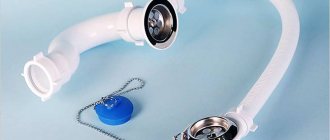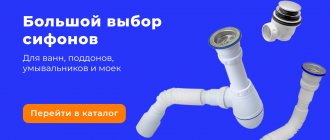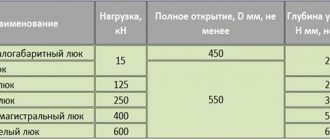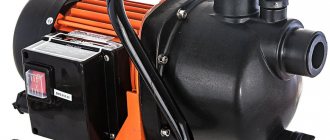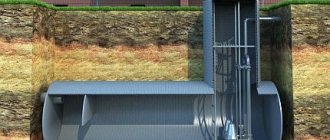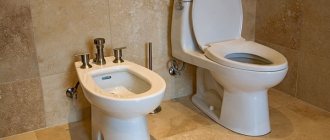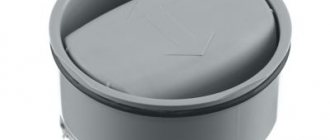A part such as a siphon is made of various materials. The most popular options today are plastic and metal. Of course, plastic parts are cheaper and more common, but stainless steel siphons last longer and are less susceptible to mechanical damage.
Today in plumbing stores you can find not only standard manual siphons, but also automatic and semi-automatic siphons. According to consumers, using such products is more convenient. The main thing is to choose a suitable model with a reliable and durable automatic mechanism.
Modern siphons are distinguished by a wealth of choice. The range of these parts allows you to choose an ideal and durable copy that will serve without causing any problems.
Installation of bath siphons
The design of most siphons consists of two parts: 1) drain block; 2) overflow block.
- The drain pipe is used for direct drainage of water and is attached to the bottom of the bathtub bottom.
- The overflow block serves to protect against water overflowing over the edges of the bathtub, so the pipe opening is located on top not far from the edges.
A bathroom drain using a siphon ensures proper water circulation and also blocks unpleasant odors from the sewer. This design has 4 parts: a neck, a pipe, an overflow corrugated hose, a soft or hard pipe that directly connects to the sewer.
The neck is directly attached to the bottom of the bathtub on both sides using a metal screw, which tightly tightens the inner and outer parts. During installation, it is important to ensure tightness using a rubber seal. The overflow neck has a side outlet through which water flows in a stream under low pressure.
The siphon pipe has a curved shape, which ensures that a certain amount of water is always inside. This water barrier prevents the movement of odors from the sewer system. To effectively perform these functions, the volume of liquid must be at least 300-400 ml, since with a small volume of water it can be automatically sucked into the sewage system.
The corrugated hose drains excess water, preventing possible overflows from the top. However, due to the low pressure of liquids, it is not necessary to use crimp structures.
The connection to the sewer can be made using more reliable hard or soft corrugated tubes, which can be adjusted in length.
When assembling a complete structure, flat or conical gaskets, screws and union nuts are used. It is important to consider that the thinner part of the gasket should go into the adjacent pipe towards the sewer.
Today, the sanitary equipment market offers drainage structures for individual baths in three main varieties:
- conventional mechanical system with plug;
- semi-automatic bath siphon;
- automatic connection for bathtub.
Types of sewerage
Usually, do-it-yourself sewerage in bathrooms in an apartment or house is installed in several stages. Each stage should be carried out taking into account certain technical features that need to be taken into account:
- installation of internal sewerage - this stage includes the laying of all sewerage elements that are located indoors, namely the connection of siphons to the sewerage system, sinks, cold and hot water supply:
- external sewage system - this stage includes laying pipes that connect the internal sewer system, drain, septic tank or central sewer system.
External
Internal
Types of siphons depending on design
Depending on the design, there are the following types of these products.
Flat. The design of such a device allows for their installation in limited space. The main part of the device, in which a water seal is formed and debris accumulates, is located horizontally. In order to clean the flat bath siphon, it is necessary to partially dismantle it.
Flat siphon - ideal for installation in confined spaces
Pipe. Such devices are made from pipe sections of different lengths, joined in a certain sequence. Pipes in this design have sufficient rigidity. This bathroom siphon is more compact than the previous type, however, due to the lack of a compartment in which debris is concentrated, cleaning it is more difficult.
Bottled. This type is distinguished by the presence of a special compartment, which is shaped like a bottle (hence the name). Garbage is collected in this compartment, and there is also a water seal in it. Bottle siphons are quite large in size compared to other types, so their installation is only possible if there is enough free space under the bathtub. Such devices can be periodically cleaned without completely disassembling the structure, which is very convenient.
Corrugated. They are distinguished by the simplest design, which includes a “drain-overflow” type device and a soft pipe. The pipe can be bent in any desired direction. A corrugated siphon for a bathtub has one drawback - the rapid formation of a blockage. This is due to the fact that the ribbed walls trap foreign particles. In addition, connecting the overflow element often causes difficulties.
Materials for internal and external laying
Before starting to lay internal networks for water supply and sewerage, the necessary materials are prepared. It is best that the color of the pipes is orange. So, replacement of sewer pipes should be made from the following products:
- pipes made of polypropylene material;
- pipes made of polyethylene material;
- PVC pipes;
- adapters;
- couplings;
- bends.
Pipes and elements
Fitting
Elements of the sewer system
For internal drainage, devices made of polypropylene material are used. This is due to the advantages of this material. The main characteristics are softness, resistance to temperature changes, and long service life.
Installation of sewer pipes is most often made from polymer-type products, the diameter of which is 110 mm. Painting pipes orange or gray is done to mark their purpose.
Types of siphons according to the method of water discharge
There are the following types of siphons according to the method of water discharge:
- manual;
- semi-automatic;
- automatic.
Automatic siphons are complex devices, but they make it easier to control the water level in the bathtub
Manual. The design of such devices is considered the simplest. These devices are equipped with a drain hole that is manually adjustable (opens and closes).
Semi-automatic. Semi-automatic devices at the manufacturing stage are equipped with a special plug with an additional cable. This plug is adjusted using a handle located outside the bathtub. As a rule, such a handle has two positions: directly draining water from the bathtub or placing a load on the overflow hole.
Automatic (click-clack devices). Such devices are the most complex in terms of execution. The automatic bathtub is able to independently regulate the water level in the bathtub bowl. In order to drain the water, in this case you just need to press the drain lid.
Important! Experts do not recommend installing automatic models yourself. This is due to the fact that their installation requires special knowledge and high precision, otherwise such a system will be ineffective.
Connecting the bathtub to the sewer - main steps
A distinctive feature of all non-pressure sewer systems inside houses and apartments is the ability to install them and connect plumbing without special tools. This cannot be said about the situation if, for example, it is necessary to connect the bathtub to the water supply.
When carrying out sewer operations, you may need a hacksaw or a grinder with any disk for cutting pipes. To screw the siphon cups, a flat or Phillips screwdriver is required.
Materials used for the manufacture of siphons
For the manufacture of siphons the following are used:
- plastic. Plastic devices are durable and low cost. It is optimal to install such equipment on a bathtub with a protective screen, since the appearance of the device is not aesthetic;
- metal: brass, bronze, chrome steel and so on. Metal siphons are suitable for acrylic bathtubs, especially those installed in the center of the bathroom. The devices, having an elegant and neat appearance, can serve as additional elements of room decor;
Siphon made of copper and brass
- cast iron. Siphons made of cast iron are intended exclusively for bathtubs made of the same material. Currently, they are practically not used, as they are large in weight and size, and also require high installation accuracy.
Device made of cast iron
If the siphon is not visible to users, then it is enough to install a plastic device.
How to install a cast iron bathtub on supports?
The large weight of the cast iron bathtub gives it sufficient stability, so you can install it on legs, without additional support. After all the preparatory work has been completed, the bath should be moved to the installation site. Since a cast iron bathtub weighs quite a lot, you will need at least one assistant.
In order to avoid accidentally damaging furniture, trim, openings and other objects when moving a heavy and bulky bathtub, it is recommended to protect problem areas in advance with shock-absorbing material.
The cast iron bathtub has a significant own weight, which allows it to be installed on supports in the form of legs without an additional base
For correct installation, follow these steps:
Place the bathtub on the floor sideways so that the bottom faces the wall and the drain is directed to the sewerage connection point
This will make it more convenient to install the siphon. Securely install the supports on the side facing up. Carefully turn the bathtub onto the other side. Install the remaining supports in the same way. Place the bathtub on legs. Using a level and adjusting bolts, level the bath so that there is a slight slope towards the drain. Move the bathtub close to the wall. Seal the remaining gap with polyurethane foam; you can also use tile adhesive. Connect the corrugated drain to the installed trim using a special gasket so that its cone is directed towards the trim. Secure the connection using a special nut. The force applied to tighten the bolts on the supports must be moderate so as not to damage the plastic base of this element
After installation is completed, it is necessary to check the quality of the work performed. To do this, close the drain and fill the bath to the brim
The force applied to tighten the bolts on the supports should be moderate so as not to damage the plastic base of this element. After installation is completed, it is necessary to check the quality of the work performed. To do this, close the drain and fill the bath to the brim.
It is necessary to inspect the installation location of the overflow, as well as the connection between the bathtub body and the drain. Leaks at this stage are most often caused by improper installation of the gasket. If leaks are not detected, you should open the plug and observe the condition of the piping.
To quickly and accurately detect leaks, you can place hygroscopic material on the floor: paper towels, napkins, toilet paper, etc. For small leaks, sometimes simply tightening the union nut is enough to ensure a secure connection.
The junction of the cast-iron bathtub to the wall must be fixed with cement mortar or ceramic tile adhesive, and then carefully sealed
Care should also be taken to ground the device. This step is simple to complete: a piece of wire is attached to the body of the bathtub, and its other end is connected to the nearest metal structures. After this, you can begin finishing work.
Bath Siphon Manufacturers
The best bath siphon is a high-quality device manufactured in compliance with all norms and regulations. It is more advisable to purchase siphons from well-known manufacturing companies that can guarantee the quality and long service life of the products. Such companies include:
- Geberit (Switzerland). The company, which began its activities in 1874, remains a leader in the plumbing market to this day. The organization's employees are constantly developing and implementing the latest devices necessary for a high standard of living for consumers. Products from the manufacturer are quite expensive, but have a high level of quality.
Installed Geberit siphon with PushControl system
- Ani plast (Russia). The company is a leading Russian manufacturer of plastic plumbing fixtures. Products manufactured by the company are annually certified and quality tested. The products are low in cost.
- Viega (Germany). The quality of products is controlled at all stages of production, starting with the supply of materials. All siphons are certified. The cost of the products is quite high, but the economic costs are justified by the long service life.
The video provides an overview of a semi-automatic siphon from Viega.
Connecting drain fittings
The assembled siphon group must be secured at three points:
- Drainer;
- Overflow;
- Sewage pipe.
First, install the fittings in the drain hole. Fixation is carried out using a screw through the drain grate. The gasket is placed on the drain itself; it has a specific shape and provides sealing on both sides at once. TIP: Apply a little silicone sealant between the gasket and the bathtub body. Do not tighten the screw all the way.
Then, by adjusting the height of the corrugated pipe, the overflow is secured. Here the gasket is installed on the outside of the bathtub. It has a conical shape, and the “point” is directed “from the bath”. The screw is tightened all the way.
After this, press the screw on the drain hole.
TIP: stop turning the screw as soon as the plane of the drain grate begins to sag.
The last thing is inserted into the sewer, waste pipe. To facilitate this process, lubricate both the pipe and the entrance to the sewer with laundry soap.
We install a drain in the bathtub
The kit for the bathtub siphon must include instructions that indicate how to properly install the siphon in the bathroom or, at a minimum, what the assembled siphon you purchased looks like. These instructions are kindly provided by the manufacturer. The assembly of classic and semi-automatic siphons is not much different from each other, but some nuances still exist and cannot be neglected.
If the device you purchased is intended to replace an existing one, then make sure that the attachment points of the previous siphon are cleared of sealant residues and the abutment surfaces are cleaned. Such measures are necessary to prevent leakage of new gaskets at their installation sites.
Assembling a modern plastic siphon with your own hands is not at all as difficult as it might seem at first glance. Having opened the box with the siphon, do not rush to get scared and call a specialist. You will do everything very well on your own.
First stage of installation
Our first task is to attach the bottom drain to the tub. Take this pipe, put a gasket in it, and then place it from the bottom to the drain hole. Install a protective grille on the opposite side of the hole in the bowl itself and tighten the connection with a screw.
Now you need to check the holes for alignment and make sure that the gasket is not warped. If this is not done, a leak may occur after tightening the screw. After making sure that everything is in order, tighten the screw while holding the lower pipe with your hand.
Second stage of installation
Now you should install the upper overflow pipe. In this case, you need to proceed in the same way as when installing the lower drain pipe. The upper pipe is also tightened with a screw. The only difference is that it is better to turn this pipe slightly in the direction from the wall to the door to make it easier to manipulate its connection with the corrugated drain pipe.
The pipes of both drain holes are connected by a corrugated tube. If it turns out to be too long, it should be curved rather than cut. If a nut is involved in the process of connecting two pipes, then it is the nut that must be placed on the corrugation first. Then comes the laying turn, after which the connection is made.
Third stage of installation
Now you need to check the “elbow” of the drain siphon, in which a water seal will be formed. There should be no defects where the gaskets are attached. The water seal must be absolutely sealed, otherwise it will not perform its main functions.
The “elbow” fastenings are the same for almost all siphon models. This is a union nut with a conical or flat rubber band. The “elbow” is connected to the corrugated tube using a union nut and gasket.
Fourth stage of installation
At the fourth and final stage, the system should be connected to the sewer drain. There are only two mounting options here. If your bathroom still has old cast iron pipes installed, the connection should be made using a sealing collar.
If the bathroom is equipped with new plastic pipes, then it is enough to make a direct connection into the pipe. You don't need any additional devices for this.
To visualize what the siphon elements should look like and how to assemble a plastic bath siphon, watch this video:
So, when the installation of the siphon is already completed, you can begin testing. To do this, you need to fill the bathtub with water and check for leaks with the drain plug closed. If it is dry under the bathtub, then we can assume that the lower pipe is correctly connected to the drain hole. All that remains is to pull out the plug and make sure that the water leaves the bowl without leaks throughout the drainage device.
Checking the quality of installation of the drainage device and searching for possible leaks is a mandatory event that will allow you to be sure that you will not flood yourself and your neighbors below
If you find a leak, disassemble the problem area and determine the cause of the problem. This could be a skewed gasket, a poorly tightened nut, or interference at the joints. Once the problem has been resolved, perform the test again.
Installation process
Before installing water supply and sewerage systems, you need to remove old pipe elements. Technical work is carried out in stages:
- the hot and cold water supply to the sink, bathtub, shower, and toilet is turned off;
- Next, remove the hose designed to supply water to the toilet tank. This process is carried out using an adjustable wrench;
- the toilet is removed - to do this you need to remove the bolts that hold it to the surface;
- The bathroom area is completely cleaned. It is necessary to remove all objects that will interfere with the laying of the sewer system networks - washing machine, bidet, sinks;
- then the old sink drain and other plumbing fixtures are dismantled. All pipe elements made of cast iron material can be broken with a hammer;
- The pipes are removed next to the riser. Carefully remove the pipe elements extending from the tee mounted in the riser. Using a grinder, you need to cut the pipe at a distance of 100 mm from the socket of the riser. The remains can be easily removed - you just need to rock them a little in the socket and then they will fall out on their own.
Dismantling old wiring
Dismantling cast iron pipes
However, if the residues do not fall out and are firmly stuck, then more effort will have to be spent on removing them. To do this, a pair of cuts are made with a grinder along the segment and up to the socket itself with a distance of 2 cm from each other. Next, a chisel is inserted into the cut, and it is tapped lightly with a hammer. Tapping is done until the pipe inside the tee cracks.
Next, the tee socket is cleaned. Before installing a new cuff on the bell, you should clean off any remaining lubricant. After installing the new cuff, pipe wiring is done.
Design characteristics of semi-automatic
The semi-automatic bath fitting has a rather complex design, which is characterized by an additional shut-off valve controlled by a lever on the overflow hole. It can be made in the form of a button, a decorative valve, or a rotary ring. Control occurs using a system of cables and other additional connecting parts. The advantages of such a siphon lie primarily in convenience and comfort of use. The closed overflow device has a high aesthetic appeal.
On the other hand, the complexity of the design and the presence of many moving parts reduce the reliability of such systems.
When purchasing siphons of this type, it is important to pay special attention to manufacturers of high-quality fittings for sanitary equipment that have proven themselves well. The durability and uninterrupted operation of these drains directly depends on this.
What are the dangers of incorrect installation and connection?
The bathroom smells like sewage - why is this happening? Residents of apartments in which the bathtub or washbasin has recently been replaced often turn to plumbers with this question. And the answer is simple - errors when installing the siphon.
If the bathroom stinks, it only means one thing:
- Either the hydraulic valve does not cope with its duties;
- Or there is a leaky connection between the siphon and the receiving tee, through which sewer odors penetrate into the room.
According to experienced plumbers, the bathroom often stinks due to the reduced radius of the drain pipe made from the corrugated hose from which the siphon is formed.
For reference: The volume of water contained in it is not enough to withstand the atmospheric pressure of the public sewer system. And it “presses through” the water plug, and unpleasant odors penetrate the room.
Features of automatic siphons
Thanks to technological progress, an improved siphon for a modern bathtub has appeared on the sanitary equipment market, working like an automatic machine. Automation provides a large selection of operating modes and additional functions. With a single turn of the knob or pressing a button, water is drawn to the desired temperature.
In this case, it is possible to maintain a certain water temperature for a certain period of time. The automatic siphon is made of brass and copper alloys, which are coated with a layer of chrome to attract external shine and chic, and also repel dirt and provide reliable protection of materials. The system is equipped with a “click-clack” valve, which greatly facilitates control due to the absence of any additional levers and handles.
Along with undeniable advantages, such drains during operation require uninterrupted electrical power and regular maintenance. In addition, automatic siphons have a fairly high cost and are also characterized by frequent breakdowns. Moreover, even the failure of a small spring requires replacement of the entire structure.
Thus, in order to choose the most optimal siphon for a bath, it is better to study in detail the statistics and nuances of the operation of certain models, look at reviews about the manufacturer and design. When choosing a particular model, great attention should be paid to reliability and durability, since drains perform invisible work, exposed to hot, cold water, and various detergents.
Options for constructive solutions for strapping
Bath frames are classified according to two criteria: by design and material of manufacture. If we take design differences as a basis, we distinguish: universal, semi-automatic and automatic systems.
Universal
The simplest version of the piping is often used when connecting and installing bathtubs of any type: acrylic, steel, cast iron.
The main requirement for installing a universal system is that the distance from the center of the overflow to the drain hole is no more than 57.5 cm
The main elements of the system are:
- Drain neck. It is equipped with a metal plate intended for installing the cover.
- Overflow neck. It has the same design overlay.
- Siphon. An element that ensures water flow and prevents the spread of sewer “odors.” It can have a collapsible or monolithic body.
- Corrugated hose. It is designed to connect the drain and overflow necks and is mounted by pulling it onto the fitting or tightening the union nuts.
The outer part of the overflow is decorated with a grille, and the return part is connected to the receiving block. A spout tube is attached to it, connected to a pipe coming from the lower outlet.
Regulation of water release in universal piping models is carried out by manually removing the plug tied on a chain
Among the presented types, the universal harness, which includes a minimum of movable elements, is considered the most reliable and durable.
Semi-automatic
The peculiarity of the system is that it is equipped with a rotating lever, with the help of which the drain neck is blocked. This mechanism is convenient to operate even while lying in the bathroom. You just need to get used to it, learning to move the lever with your toe.
The operation of the semi-automatic bathtub harness is based on the mechanical principle. The device is driven by a rotation lever or valve installed on the siphon overflow neck. The starting lever, similar to a bicycle gearshift, is connected by a cable to another lever located in the drain neck of the device.
By turning the rotation lever in one direction or another, the cable is tightened or, on the contrary, weakened, under the action of which the plug located above the drain hole is lowered or raised.
The main advantage of such a system is ease of use: to lift the plug and drain the water, you don’t have to bend over into the bathtub
Consumers who have installed semi-automatic drainage systems in their bathrooms complain about the fragility of the design. All you have to do is press a little harder on the plastic lever and it may break.
Automatic system
Automatic systems are devoid of any cables or fragile elements. The drain neck is opened by pressing the plug.
Under the action of a spring, supplemented by a latch, the plug, when pressed, easily rises above the surface, ensuring free flow of water. When pressed again, it lowers, covering the neck of the drain hole.
External accessories for an automatic bathtub can be made in any color: white, painted bronze, gold or silver metal
The disadvantages of the system include only the small size of the hole that remains under the drain plug. Hair and small debris often accumulate in it, making it difficult to drain the water.
In low-quality products, the increased complexity of the design often leads to breakdowns, which cannot always be repaired. And the problem can be eliminated only by completely replacing the automatic system.
To protect yourself from unexpected expenses, choose equipment from trusted manufacturers. The best choice is automatic bath trims made of metal.
Siphon care
To ensure the durability and high performance of this plumbing fixture, it must be properly cared for. The bathtub siphon should be inspected regularly for leaks or mechanical (physical) damage.
Recommendations for caring for the siphon:
- To avoid the accumulation of scale and other deposits on the walls, you need to flush the siphon with hot water and citric acid at least once every few months. You can also use special chemical cleaners (suitable for the material of your device). It could be “Phlox”, “Ruff” and others;
- On average, every 6 months, rubber gaskets lose elasticity and become thinner. If the siphon begins to drip, this is a sure sign that it is time to replace them;
- To prevent the drain in the bathroom from becoming clogged, you need to periodically clean the water seal. This is the place where water and various contaminants (hair, for example) collect. To do this, the water is shut off, the siphon is disassembled “up to the knee” and cleaned. Afterwards, the joint must be treated with sealant and wait for it to dry;
- If cracks or chips are found during the next inspection, then the siphon needs to be replaced. Such faults cannot be repaired and pose a real danger of flooding the apartment.
Prevention of unpleasant odors
Often unpleasant odors come from the sewer system. To avoid this, when installing plumbing in the bathroom, you should follow the following rules:
- lay the sewer system using wide pipes. Because in products of small diameter the pressure often changes, which is the first cause of the appearance of an unpleasant odor. But in wide products, during the movement of liquid, an air cushion is created, blocking the escape of odors to the surface;
- be sure to clean the pipes in a timely manner;
- Stagnation of waste and water at the site of the siphon can lead to rotting and the appearance of an unpleasant odor. Therefore, the siphon should be constantly cleaned of various wastes and liquids;
- Another reason is faulty ventilation. Stagnant air in the room can lead to the development of fungus and mold. Therefore, you need to monitor the operation of the ventilation and eliminate any malfunctions.
Wide pipes should be used for the bathroom drainage system
Selection rules
Choosing a siphon is quite difficult, since it is presented in a huge number of types, differing in design, functions performed, material of creation and other parameters. In the selection process, the method of fastening the product must be taken into account, and this is especially true if you plan to do the installation work yourself.
The simplest installation is considered to be one that uses bolts to secure metal outlets. However, removing the pipes for cleaning will be difficult, and all metal parts are subject to corrosion. If you plan to create a room in a certain unique style, then you often choose a special frame for the overflow washbasin that matches the design.
During the selection process, it is important to check that the kit includes all the necessary elements for installation and operation of the product. It is advisable to take into account important factors when selecting a model:
- there must be a grate covering the drain and overflow, which will provide protection against various foreign objects entering the sewer;
- the kit must certainly include a plug that covers the drain hole, and it can be made of plastic or rubber, and is also fixed to the overflow with a chain;
- the manufacturer of the product is taken into account, since it must be reliable and proven;
- the material from which the structure is made must be ideally suited for the bathtub itself or other plumbing fixture, and must also be of high quality, durability and resistance to numerous exposure factors found in the bathroom;
- cost is also considered an important parameter for many buyers, and automatic designs are considered the most expensive, so they are usually installed in bathrooms designed in a luxurious and unique style;
- parameters of the bathtub or sink for which the product is selected, since installation can be simple and quick only if both elements match perfectly.
It is not recommended to purchase siphons equipped with components made of hard materials, as this significantly complicates the installation process, so flexible tubes are considered optimal.
Thus, the process of choosing a high-quality siphon for any plumbing fixture is an important point in increasing the comfort of water procedures. It is presented in several varieties, differing in design, material of creation and other parameters. In the selection process, it is recommended to take into account the advice of experts in order to get a truly high-quality and durable product that copes well with its main tasks.
Operating principle
First, let's look at how the sewage system works in the bathroom:
- A bathtub filled to the brim discharges part of the water through the drain-overflow system;
- When the drain hole is opened, water from the bath enters the siphon;
- Bypassing the water seal, wastewater passes through a sewer pipe (hose) connected to a tee;
- Through the sewer tee, wastewater enters the riser.
Materials from previous years
A couple of decades ago, when there was no heyday for PVC products, all sewage systems were assembled from cast iron. In particular:
- Siphons and receiving pipes;
- Washbasin elbow;
- Apartment sewer pipe tee;
- Inspection window on the riser;
- The riser itself is in the apartment.
And to seal the connection, in addition to traditional tow, the following were used:
- Cement mortar;
- Liquid glass
- Epoxy adhesive
- Rubber, etc.
Modern materials
But with the advent of the era of plastic, everything has changed. Today, almost any adult man can assemble and connect a sewer siphon.
Doesn't work well: what to do?
Over time, many users encounter poor performance of the siphon and the entire drainage system as a whole. The causes of such problems may lie in improper installation of all components of the structure or in clogged pipes.
Mechanical blockages
Mechanical blockage of pipes can be caused by sand and pebbles from shoes, animal hair, human hair and many other similar little things getting into their interior. All these components certainly lead to serious blockage of both the pipes and the siphon itself. Because of this, the water from the bathtub usually drains very poorly and slowly.
This problem can only be resolved by thoroughly cleaning the pipes. However, in order to avoid such events, it is worth installing a special fine mesh on the drain hole, which will prevent foreign particles from entering the pipes and siphon.
Operational
Such blockages usually result from simple improper use of the bathtub. In this case, clogging of the pipes and siphon may occur due to dirt and particles that should remain on the protective mesh, but, unfortunately, not everyone uses it. In addition, a combination of grease and cold water often leads to operational blockages.
Technogenic
Water may not drain well due to an inexperienced technician who made many mistakes while renovating the bathroom in your home. Or maybe the fact is that the installation or replacement of plumbing in the room was not carried out according to technology. For example, you could have chosen the wrong level for installing objects or made the wrong drainage slope as it should be.
To get rid of these problems, you need to either dismantle the plumbing (if it is installed incorrectly) or remove blockages that have accumulated in the pipes.
- Thoroughly clean the siphon and drain - these are the main and vulnerable places where garbage collects first. To do this, you need to remove the siphon and unscrew the protective mesh behind it. Please note that this must be done with both the bathtub and the sink in the room.
- Now shake out all the removed parts into the toilet.
- Then thoroughly rinse the siphon, completely free of contaminants, and with it all tubes, bowls, gaskets and protective mesh.
- Wash all parts with a brush and a high-quality cleaning agent that has a degreasing effect.
- Do the same with the mesh located on the sewer openings - these are the central areas where blockages accumulate.
- Clean the corrugations that lead directly to the sewer.
You can also clean pipes and corrugations mechanically. While the external elements of the drain are drying, mechanical devices should be used to clean the system. For this purpose, a cable with a handle is most often used. It should be screwed into the depth of the sewer, trying to lower it as low as possible. After this, you need to remove the cable and repeat the work done. It is advisable to do this several times to be sure of the ideal frequency of the pipes.
Next, you should move on to chemical sewer cleaning. To do this, it is necessary to pour chemical compounds into the sewer that are designed directly to break down fats and soften plaque. There are quite a lot of such funds. Some of the most popular are products such as “Mole”, “Tone”, “Tiret” and others. It is recommended to leave these products on for 15-20 minutes. Some wait a little longer than 40-50 minutes. After the required amount of time, you should turn on the water in the bath for 10-15 minutes to remove all aggressive chemicals.
How to lay out pipes and install a riser
The most suitable location for the riser is the toilet. Because the optimal parameters of the pipe that is installed between the toilet and the riser are 100 mm. It can be installed either openly or hidden, it all depends on how the pipes themselves will be installed - in special boxes, inside wall structures, in channels, niches or near walls using fasteners, clamps, staples.
The pipes in the bathroom and the riser are routed using oblique tees. And in areas where pipes with different diameters are connected, adapters must be used. In the areas of intersection of pipes and sink, siphon, bathtub and shower, a collector-type pipe with a diameter of 100-110 mm is installed. The presence of a siphon and a water seal will provide protection from unpleasant odors. It is extremely important that the siphon is installed correctly, otherwise unpleasant odors will come out of the drain hole of the sinks or bathtubs. The presence of a siphon ensures the normal operation of the sink and bathtub drainage system.
Pipe routing option
How to properly install a sink and sink with your own hands
The easiest way to install a sink is on brackets
The main thing when installing brackets is to pay attention to the reliability of the wall to which they are attached
The sink should be installed after all finishing work has been completed. Before installing the sink with your own hands, you need to make markings. First of all, a horizontal line is measured, which, according to the standards for installing a sink in a bathroom, should be at a height of 80-85 cm from the floor. Having attached the brackets to the sink, you should measure the distance between them, and then attach them to the wall and mark the locations of future holes on it.
At the marked points you need to drill holes, and then hammer dowels into them and screw the brackets. After this, you can install the sink on the brackets and secure it in accordance with the design features. After installation, you need to check the reliability.
Having installed the sink, you can begin installing the siphon. After inserting the drain into the sink, it should be sealed with a rubber gasket and then tightened with a nut from below.
After this, a locking nut with a wedge-shaped locking ring is installed. The outlet pipe must be disconnected from the siphon. The exception is when the pipe is flexible and can be left in place. Then sealant should be applied to a rubber ring with an outer diameter of 70 mm and an inner diameter of 35 mm (according to the size of the siphon pipe) and insert it into the sewer socket until it stops.
After the pedestal is installed, a siphon is attached to the washbasin. To connect the sink to the sewer, the siphon outlet pipe, equipped with an O-ring, must be inserted into the sewer socket.
Installing plumbing fixtures in a private home such as a kitchen sink, although not fundamentally different from installing a sink in a bathroom, still has some peculiarities.
Before installing a sink with your own hands, first of all, install the water fittings - mixer and other additional accessories. Then a combined sink drain system or a simple drain assembly is installed and a compression connection is made to the sink siphon.
Cold and hot water are shut off. The new sink is mounted into the countertop of the kitchen unit. Typically, the sink base does not have a back wall, which facilitates the free connection of water communications to the pipeline. Then new water pipes are installed.
Now you know how to properly install a sink in the bathroom and a sink in the kitchen, which means it’s time to learn about connecting the toilet to the sewer.
Rating of the best manufacturers
In order not to get into trouble and not suffer with a problematic product of dubious quality, you should purchase products from well-known and trusted European companies. They produce equipment according to generally accepted international standards and norms.
Geberit . A high-quality Swiss brand with a wide range of products at mid-range prices. The product is easy to use and adapts well to non-standard sizes.
Most designs have an adjustment plug near the overflow hole that opens the drain plug
Alcaplast . One of the largest manufacturers of sanitary ware in Eastern and Central Europe. The Czech brand produces devices with a special design and simple construction, which stably and silently perform their functional tasks throughout their entire service life, regardless of the influence of aggressive environmental factors.
Kaiser . Manufacturer from Germany, producing trims for modern bathtubs. The company's products allow you to adjust the length of the siphon over a wide range, which makes it possible to easily install it, including in deep bowl models.
Viega . A German company that has established itself in the market as a manufacturer of safe plumbing products of the highest quality that can last about half a century. They successfully combine design and engineering ideas.
The assortment includes drain-overflow systems with different shapes, materials, and color variations. They are characterized by a relatively low price and simple installation.
Many Viega models have a water filling function. They are convenient for rooms where there is not enough space to install a faucet.
Hansgrohe . Another representative of good German quality. The company's harnesses are reliable, efficient, and feature a complex, high-tech structure. In interiors they are valued for their functionality and excellent decorative performance.
